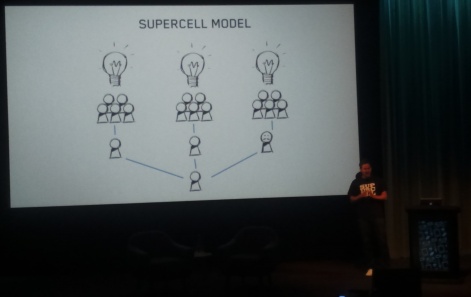Johannes Heinze is Managing Director for EMEA at AppLovin.
Sometimes I wonder what really constitutes an indie developer in a market with free global distribution and low entry barriers.
The main distinction I see is that indies mainly (sometimes solely) focus on building cool games, while the financial and business considerations come second.
Don’t get me wrong, I respect and admire the passion for creating great entertainment. But many seem to ignore that most successful gaming companies are led by entrepreneurs who spend the majority of their time building businesses to shape and protect cultures that enable developers to thrive and produce unique experiences.
Ultimately, the culture, people, and, of course, the output of successful games evolve into an interesting asset for institutional investors.
Neil Rimer, the Index Venture Partner who led Supercell’s $130 million Series B round, wrote a great blog post on why they invested into the company: “Supercell is organised as a collection of small, independent teams, called cells, tasked with developing new games or building new deep features for existing games.”

These cells follow a “Build-Test-Refine-Test-Kill” cycle to reduce development time, evaluate and iterate on the product consistently, and in many cases, kill the result after a couple of months.
More and more successful game developers have discovered and implemented lean principles to evaluate game ideas faster and ultimately reduce “waste” in the development process early by making data-driven decisions.
I’ll illustrate these principles in practice by describing how Gram Games follows a clearly defined process to build, test, iterate and grow some of the most successful hyper-casual games on the market.
More and more successful game developers have discovered and implemented lean principles to evaluate game ideas faster.
The lean framework is specifically useful for this genre of games, since the appeal as well as the scaling potential can be evaluated early on, while keeping the investment at a bare minimum.
The Lean Startup methodology
The Lean Startup methodology was coined by Eric Ries and laid out in detail in his book Lean Startup.
The methodology “favours experimentation over elaborate planning, customer feedback over intuition, and iterative design over traditional ‘big design up front’ development” to ultimately reduce risk and enable data-driven decisions. (HBR) There is a lot of literature available on the topic, but for this piece I’d like to focus on two key principles:
- The Build-Measure-Learn loop: “A learning cycle of turning ideas into products, measuring customers' reactions and behaviours against built products, and then deciding whether to persevere or pivot the idea.” (Wikipedia)
- Minimum-Viable-Product (MVP): “The version of the product that enables a full turn of the Build-Measure-Learn loop with a minimum amount of effort and the least amount of development time.” (Eric Ries)
Gram Games
The name already says it all: Gram develops minimal and “lightweight” hyper-casual games that tick all characteristics. Have a look at 1010!, Merged!, or Six!. You can play the games instantly without any commitment.

The core game is simple but enjoyable and monetisation is primarily done through ads. Gram is one of the pioneers of the ad-funded hyper-casual vertical – combined, the three games have amassed more than 100 million downloads to date.
The company’s founders’ commitment to the Lean Startup methodology and data-driven decision making is what makes it unique. Both concepts have been institutionalised in the organisational framework:
BUILD
In order to ensure a constant flow of original game concepts, Gram dedicates every Friday to developing core game MVPs. The MVP consists of a very simple (but working) prototype of the core game idea as well as a video highlighting the gameplay.
MEASURE
Gram allows two of these Prototyping Fridays before the MVP needs to be uploaded to Google Play to evaluate product-market fit. The goal is to measure key performance indicators (KPIs), such as interest in the game (click and conversion rates) and retention (early engagement rates) of users by doing paid UA, utilising the gameplay video.
In order to ensure a constant flow of original game concepts, Gram dedicates every Friday to developing core game MVPs.
LEARN
If the measured KPIs are below a given threshold, the concept will be killed and the focus will shift to the next MVP. On the contrary, if the early engagement rates look promising and the conversion rates of the videos result in low initial user acquisition costs, the developers start iterating on the game and try to increase the metrics by starting another Build-Measure-Learn loop.
REPEAT
The very best MVPs evolve over time into real games and go into soft launch, which is mainly for testing the monetisation and long-term retention of the game in different geographic regions.
One of the most important factors for ad monetisation is the amount of ads that are being served to a user on a daily basis. On top of increasing the retention, additional KPIs are added, such as the amount of average daily sessions by users and the session lengths.
A Gram Original
The games that make it through the soft launch are now “Gram Originals” and are transitioned to the main Gram App Store account for global launch. This launch is usually kicked off with a cross-promotion from their other properties.

At this point, the rigorous testing and data collection pre-launch enables them to map their LTV accurately and do aggressive user acquisition to reach scale quickly. All of Gram’s existing games went through this process and helped Gram to grow to 60 employees across two offices in London and Istanbul.
Less is more
Given the flood of new content popping up in app stores every day, it becomes increasingly important to start making data-driven decisions to evaluate product-market fit early on.
Obviously, there are limitations to this approach, and the more complex the core and the meta game get, the more difficult it is to accurately evaluate and collect data to properly forecast a game’s potential.
In my recent series, I outlined a new category – hyper-casual – and I'd argue that it and lean methodology compliment each other. The Lean Startup movement positions itself against the complexity of big corporations in streamlining development and organisation.
Hyper-casual, on the other hand, is the answer to the increasing complexity and production costs in stripping down the gameplay to what’s essential: having a game that’s fun to play – not only for a small niche of people that can afford to play it, but literally everyone.






















